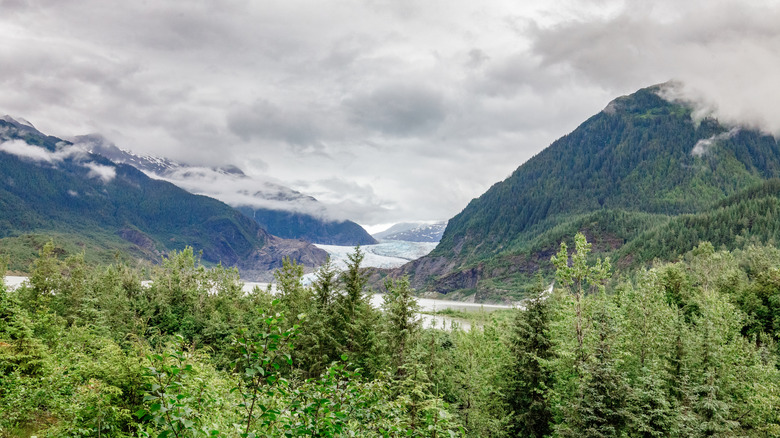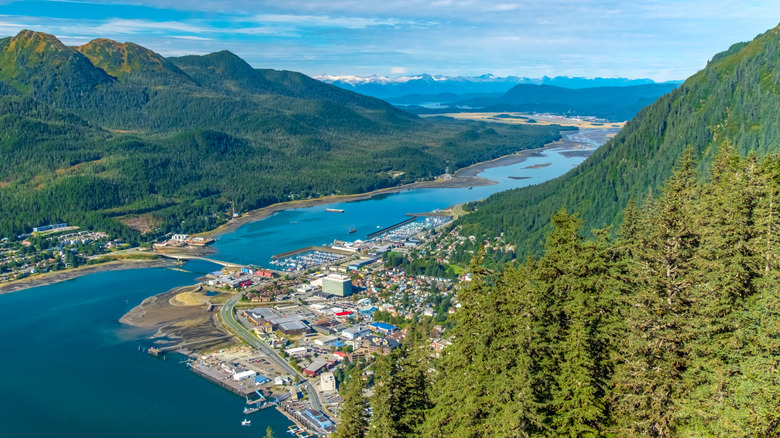This Underrated US State Capital Is A Breathtaking Destination Full Of Scenic Nature
On the North American Continent, there is one state capital that is so off the beaten path that there is no actual physical path there from the outside. Juneau, Alaska's capital, is unlike any other state capital in the United States. Set in a temperate rainforest between towering Mount Roberts, Mount Juneau, and the Gastineau Channel — a flooded valley in the Inside Passage — Juneau boasts breathtaking scenery and wildlife at every turn. Better yet, the city's deep history sets the stage for a magnificent waterfront, as well as breathtaking mountain and wildlife views.
Prior to Russian colonization and America's purchase of the Alaska Territory, Alaska natives — the Tlingit (pronounced "clink-it"), Haida ("high-da"), and Tsimshian ("shim-shee-an") — lived around Juneau for thousands of years. However, once Richard Harris and Joseph Juneau, the city's namesake, discovered gold on Gold Creek with Tlingit Chief Kowee in 1880, prospectors began to flood the area. While mining became a key part of the city's economy until the end of World War II, tourism is now one of the city's key industries. In fact, nowadays, Juneau hosts more annual visitors than Alaska's total population.
To reach Juneau, you'll most likely arrive by boat or by plane. The Alaska Marine Highway runs ferries year-round from the underrated and charming town of Bellingham, in Washington, all the way to Juneau. This journey takes about three days. Another more popular option is to visit by cruise. Alaskan cruise itineraries to Juneau are not only great for travelers who are worried about seasickness, but they'll also bring you up close and personal with "The Last Frontier." If you'd rather fly, Juneau International Airport (JNU) is served by Alaska and Delta (seasonally), along with several charter and regional airlines operating flights throughout the state.
Wildlife and trails await just outside of town
Juneau sits at the heart of one of the world's most ecodiverse marine regions and the Tongass National Forest, the second largest rainforest in the world. The area's rich forests are home to millions of acres of spruce, cedar, and hemlock trees alongside incredible wildlife — including black bears and mountain goats. Visitors hoping to get a bird's-eye view of the majestic forest, Inside Passage, and maybe even pass a few soaring eagles, should hop aboard the Goldbelt Tram to Mount Roberts and the cultural heritage center, located 1,800 feet above the city.
If you'd rather hike to the viewpoint, lace up your boots and hit the challenging Mount Roberts Trail to Father Brown Cross, located just past the tram stop. The trek is approximately 1.8 miles one-way and is noted to be incredibly slippery when the ground is wet, so be sure to bring a trekking pole and wear appropriate footwear. If you'd rather not slide down, a scenic tram ride to the base is free for visitors who spend at least $20 in the gift shop or restaurant. Just don't lose your receipt!
Brimming with more than 250 miles of hiking trails into the Alaskan wild, Juneau has adventures for hikers of all abilities — from popular day trips to a grueling climb up Mount Juneau. The quick hike to the thundering, 377-foot Nugget Falls, for example, is located approximately 12 miles north of downtown beside Mendenhall Lake — one of the most popular outdoor recreation areas and wildlife viewpoints near the city. For a more rugged trek, tackle the 6.3-mile round-trip West Glacier Trail. It gets tougher as you go, but you'll be rewarded with incredible panoramic views. Don't forget your bug spray and waterproof boots, and always be prepared for a potential bear encounter.
Enjoy incredible waterfront experiences in Juneau
Juneau's scenic nature is not only found on land, but also in the gorgeous Gastinau Channel. Alaska's Inside Passage is home to hundreds of humpback whales and millions of salmon (and legendary fishing, too). From spring to fall, five species of salmon return to the rivers around Juneau to spawn. During these runs, orcas, bald eagles, and bears also flock to feed. If you're wanting to see National Geographic live, visit the Steep Creek viewing site near the Mendenhall Glacier Visitors Center. There, you'll find plenty of short, kid- and mobility-friendly trails paired with a safe environment. Be sure to bring your cameras, too, as you'll likely get incredible photos.
For a unique culinary experience that ties together Juneau's mining past and its incredible seafood, make sure you try a salmon bake. A great spot for this is Gold Creek Salmon Bake, where diners can enjoy all-you-can-eat salmon, sides, and toasted campfire marshmallows set in the lush forests where Joe Juneau and Richard Harris once discovered gold.
Unlike the sunniest shores of Maui, Juneau has over 220 days of rain every year — mainly in the stormy fall. That said, from March to May things are normally drier, and you may even catch a glimpse of the aurora borealis until mid-April if the skies are clear and the conditions are right. While summers have long 18-hour days and are peak time to see Alaska's magnificent wildlife, the small state capital of 33,000 can have a tremendous influx of over 20,000 visitors per day, especially since multiple cruises dock between April and October. Ultimately, if you do plan to visit during the summer, be prepared for crowds and more expensive accommodation.


